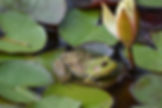Walk Softly – Jaws vs. Anaconda I
- Geoff Carpentier
- 5 days ago
- 3 min read

by Geoffrey Carpentier
The observant, amongst you, will notice, as I continue the discussion of animals’ mouths and jaws, I cleverly modified the title of my first column “Jaws” which was about fish, to morph into discussions about other groups of creatures, blending the Jaws movie title with the titles of other animal focused movies. Well, I thought it was clever even if you don’t!
Future columns will include Jaws vs. Anaconda II, Jaws vs. The Birds, Jaws vs. King Kong and finally Jaws vs. The Fly. Which should cover most of the critters with jaws and mouths, i.e. fish, reptiles & amphibians, birds, mammals and insects/invertebrates. This column and the next discuss adaptations of reptiles and amphibians, as they use their mouth parts and jaws to capture and hold prey.
Many of the animals within this group have teeth, but of course, just to complicate things, others don’t. As discussed in the previous column about fish, the mouth parts still look essentially the same, an upper and lower jaw persists, with a hinged joint, to allow them to open and close their mouths with or without force, depending on what and how they eat. One might think, at first glance, all herptiles, the collective name for reptiles and amphibians, all are carnivorous who only eat fish, insects, birds or mammals and the like. Not true! One only must think about tortoises, to realize some reptiles eat a great deal of plant material. Likewise, the Green Iguana eats vegetation, fruits and seeds as part of its diet. In the realm of amphibians, fewer of these are herbivores, but at least one Brazilian treefrog, i.e. Izecksohn’s Brazilian Treefrog, eats fruits and flowers as part of its diet. Recall also, many immature amphibians live in the water, e.g. Tadpoles, and feast on algae and bits of plant debris for much of their sustenance, until they morph into adults.
Caecilians, i.e. limbless, worm- or snake-shaped amphibians with either small or no eyes, live mostly underground and are ambush predators, meaning, they lie in wait for their prey to come close. They rely heavily on their sense of smell and touch to find food. They possess sensory tentacles near their nostrils which help them detect vibrations and chemicals in the environment. Once they know prey is near, they strike quickly, using their sharp, peg-like teeth to grasp and hold onto their prey. They generally swallow it whole or, in some species, use a rotational motion of the mouth to help tear off pieces of larger prey.
Salamanders also are ambush predators, generally, utilizing their strong sense of smell and their ability to detect vibrations in the water to find prey. They hunt in aquatic or terrestrial habitats, and their hunting technique is very different than that utilized by frogs and toads. Smaller salamanders have a specialized tongue. They contract muscles, causing the hyoid bone to rapidly protrude, launching the sticky tongue to capture prey. Most frogs have teeth, but they are not used for chewing. Frogs are stealth hunters, who trap their prey with their sticky tongues. Their saliva is the agent which starts off liquid-y but rapidly hardens when in contact with dinner. Frogs primarily have teeth, only on their upper jaw, called vomerine teeth which are used to hold prey in place before swallowing it whole.
Many salamanders actively pursue their prey, using their keen sense of smell and vision, as they move through either the aquatic or terrestrial habitats, depending on their life stage. Recall that, many amphibians live in the water, at least for the first part of their lives, then occupy, either, a terrestrial, arboreal, fossorial, i.e. underground, or aquatic habitat, as adults. As their habitats and feeding strategies and techniques are extremely variable, they must have various ways to capture, hold, and ingest their prey. Many amphibians (e.g. chameleons) have sticky tongues which unfurl at lightning speed, to catch their prey, which is ground into small pieces by the bony outer lips and sharp teeth and then swallowed.
Okay, we’ve figured out the amphibians, so, in the next column, we will explore feeding strategies in some of the reptiles.
Geoff Carpentier is a published author, expedition guide and environmental consultant. Visit Geoff on-line on LinkedIn, Facebook and Instagram.




